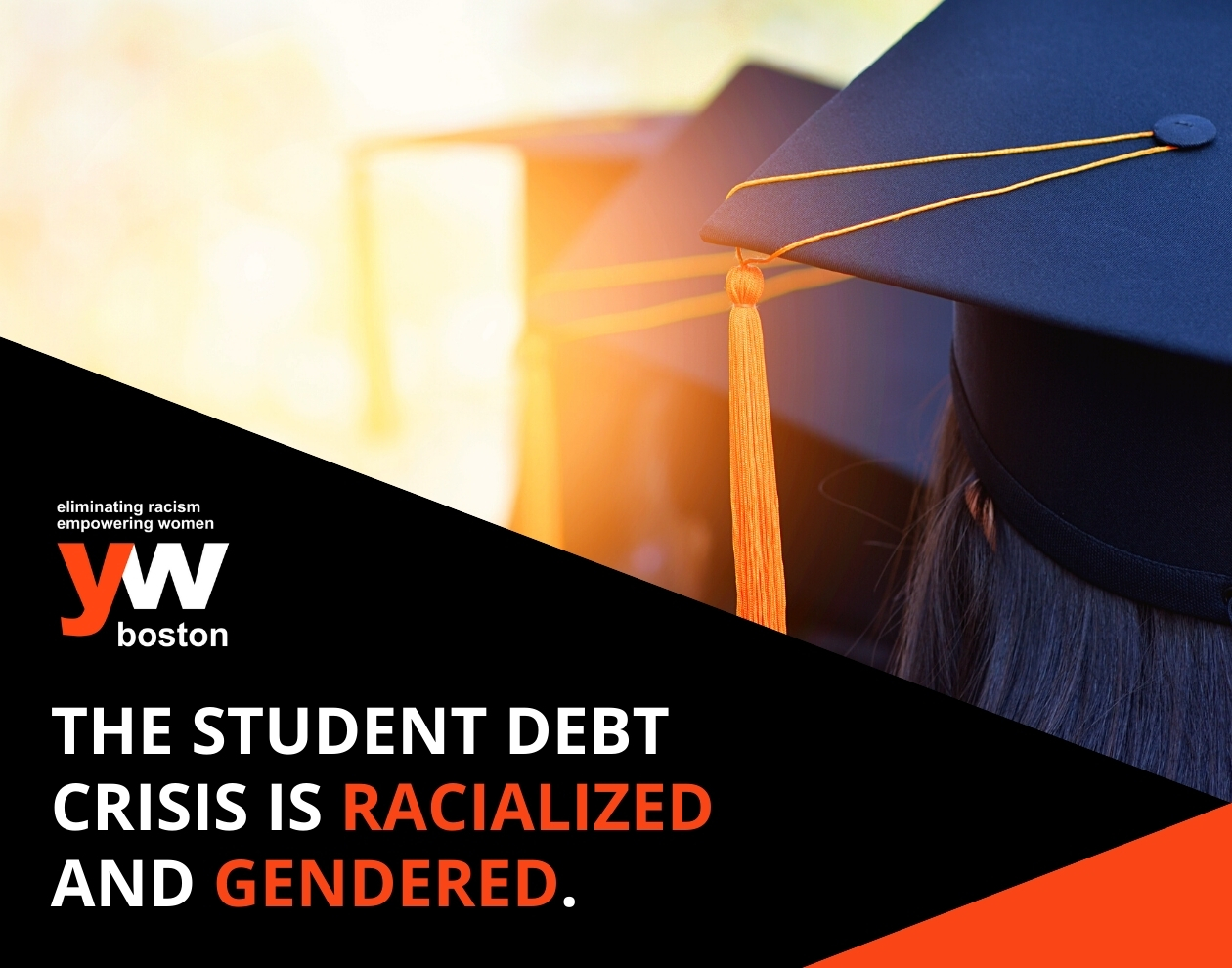
June 24, 2021
By: Jordan Ziese, Public Policy and Advocacy Senior Coordinator
The student debt crisis is racialized and gendered. Here’s our guide to understanding it.
There are currently 42.9 million federal student loan borrowers who owe a collective $1.59 trillion in outstanding debt that financed their educations, according to the U.S. Department of Education. Private loans account for another $131.81 billion of student borrowing. By this point these are well known and oft-cited figures, meant to represent the enormity of a seemingly insurmountable problem caused by historic underinvestment in our nation’s higher education system. What these number obscure is the ways in which systemic inequities impact access to higher education for women, people of color, and especially women of color.
In service of our mission to eliminate racism and empower women, YW Boston’s Advocacy Committee believes it is crucial for all people to have access to debt free higher education. This legislative session, we support Massachusetts bill An Act to Guarantee Debt Free Public Higher Education S.829/H.1339. It is crucial that we examine the racial and gendered aspects of student debt. The following is an exploration of the need for us to talk about the student debt crisis as the racialized and gendered catastrophe that it is. Only then can we understand how to best approach solutions that undo the disparate impacts of the pursuit of knowledge.
Student loan debt is furthering racialized homeownership and credit gaps.
One in eight Americans hold some kind of student debt, but those borrowers are disproportionately Black and Latinx. Black college students take out more debt because of generational wealth disparities, take longer to pay it off, are more likely to default on those loans, which then prevents families from having the opportunity to build generational wealth. Latinx students face similarly inequitable access to funds to finance their higher education.
Student loan borrowers have a much harder time purchasing homes, the main investment and source of financial security for American families, with Secretary of Housing and Urban Development Marcia Fudge telling a reporter in June of 2021 “Who has student debt? Poor people, Black people, brown people. We’re the people who carry most debt. And so the system’s already skewed toward us not being creditworthy.” Secretary Fudge recently announced that the Federal Housing Administration would make it easier for those with student loans to qualify for FHA-insured mortgages which would have an exponential impact on borrowers of color and their ability to finance a home after financing education. Additional problems around access to credit emerge if borrowers default on their loans, as Black and Brown borrowers are five times more likely to do than white borrowers. Those in default will have a hard time raising credit scores which affect access to housing and wealth building tools like credit cards, and can see wages garnished in an attempt for the federal government to collect on the debt. Representative Ayanna Pressley, the first Black member of the Massachusetts congressional delegation, sharedin early 2021 that she herself defaulted on loans taken out for her college education.
Student debt constricts parents’ choices.
Women are also disproportionality impacted by the mounting pile of student debt, making up 57% of students but 66% of borrowers. Not only do they come out of college with more debt, but they also take longer to pay it off because of deeply ingrained pay disparities and lack of access to necessities like paid paternal and family leave and affordable child care. According to the American Association of University Women, women have an additional $3,200 in debt than men, on average. Women also make 26% less than men, on average, putting them in a double bind of having more debt to pay off with less income to pay it with. The gap is most pronounced between Black men and women and white men and women borrowers with Black women having the highest amount of debt.
For women the crisis is further compounded by childcare costs, which disproportionately fall to women, and are especially hard to finance while gaining a degree and then paying it off in the following years. In 2014 there were nearly 3.5 million women with children enrolled in college, 71% of parents in school. Half of all Black women and a quarter of all Black men enrolled in college are parents. Student parents are twice as likely to default on student loans, and 70% of single parents will default, with 54% of parents never finishing their degree. Because of student loans, the monumental expansion Child Tax Credit program in this spring’s CARES Act might not make it to some of these parents. Parents who have defaulted on federal student loans are at risk of having that money seized by Treasury Offset to involuntarily make payments on those loans unless the Biden administration acts quickly to close that loophole and ensure the families most in need of this assistance actually see it.
These factors make it even harder to achieve one’s goal of earning their degree.
Then there are borrowers who started but have yet to finish a degree, often because of troubles financing huge tuition payments partway through their education. These borrowers are three times more likely to be in default than borrowers who finished their degrees, making it a nearly impossible proposition to finish the degree that promises higher wages as those in default no longer have access to federal student aid. Best estimates show that among Black student borrowers, a majority do not complete their degree within six years.
Lots of (important!) chatter this week about the number of people with student loans and no degree or credential. Among those who take out loans, about 4-in-10 students overall, including 54% of Black students, do not finish college within six years. pic.twitter.com/nc7DOm15BD
— Mark Huelsman (@MarkHuelsman) November 20, 2020
It is also well known that for-profit colleges have some of the lowest graduation rates, disproportionately enroll women and Black students, and those students are four times more likely to default on their loans than two year college students. Earlier this month, President Biden cancelled $5 million in loans for 18,000 students at a for-profit institution that has ceased operations and been accused of lying to students, thought the Department of Education and Department of Justice are still reviewing his authority to more broadly cancel federally held education debt.
NAACP President Derrick Johnson said earlier this year that “You cannot begin to address the racial wealth gap without addressing the student loan debt crisis.” We must understand the growing student debt as the gendered and racialized crisis that it is. Dismantling the student debt system alone does not solve these inequities, but trying to solve the crisis without recognizing the systems at play will only yield inequitable results.
For this reason the YW Boston Advocacy Committee has chosen college access and affordability as key to our racial justice policy priority. If you would like to take action on eliminating the college debt crisis you can:
- Sign up for our advocacy alert newsletter (below).
- Sign the Public Higher Education Network of Massachusetts’ letter to President Biden asking that he cancel student debt.
- And in order to prevent more individuals from taking on student debt, write your Massachusetts legislator in support of An Act to Guarantee Debt Free Public Higher Education S.829/H.1339.
Be the first to learn about action items related to our priority legislation! Sign up for YW Boston’s Advocacy Newsletter:
______
About YW Boston
As the first YWCA in the nation, YW Boston has been at the forefront of advancing equity for over 150 years. Through our DE&I services—InclusionBoston and LeadBoston—as well as our advocacy work and F.Y.R.E. Initiative, we help individuals and organizations change policies, practices, attitudes, and behaviors with a goal of creating more inclusive environments where women, people of color, and especially women of color can succeed.
YW Boston Advocacy Committee
The Advocacy Committee supports YW Boston’s mission to eliminate racism and empower women by engaging elected officials, organizations and the public through legislative advocacy, coalition building, education, and action. The committee develops and implements the organization’s two-year advocacy agenda in order to rectify structural barriers to equity and opportunity for women, girls, and people of color.

